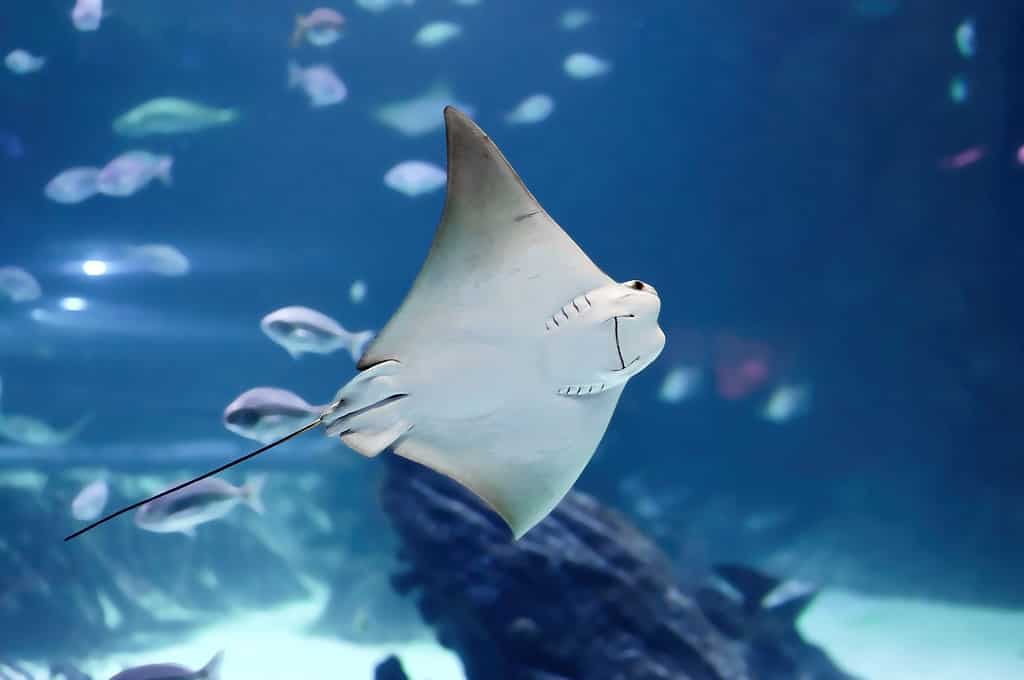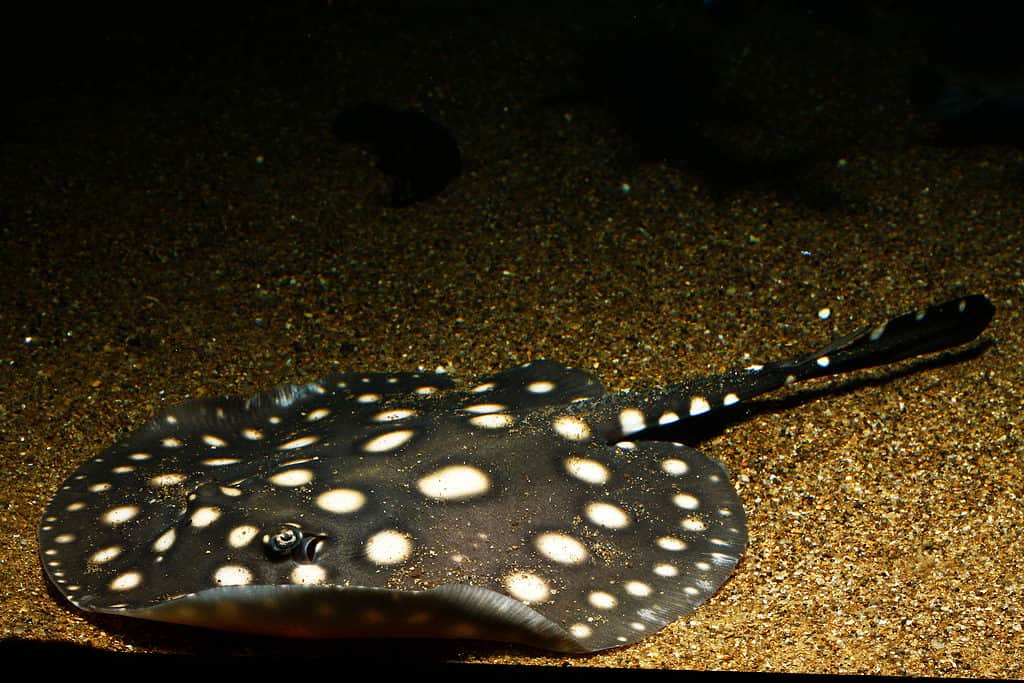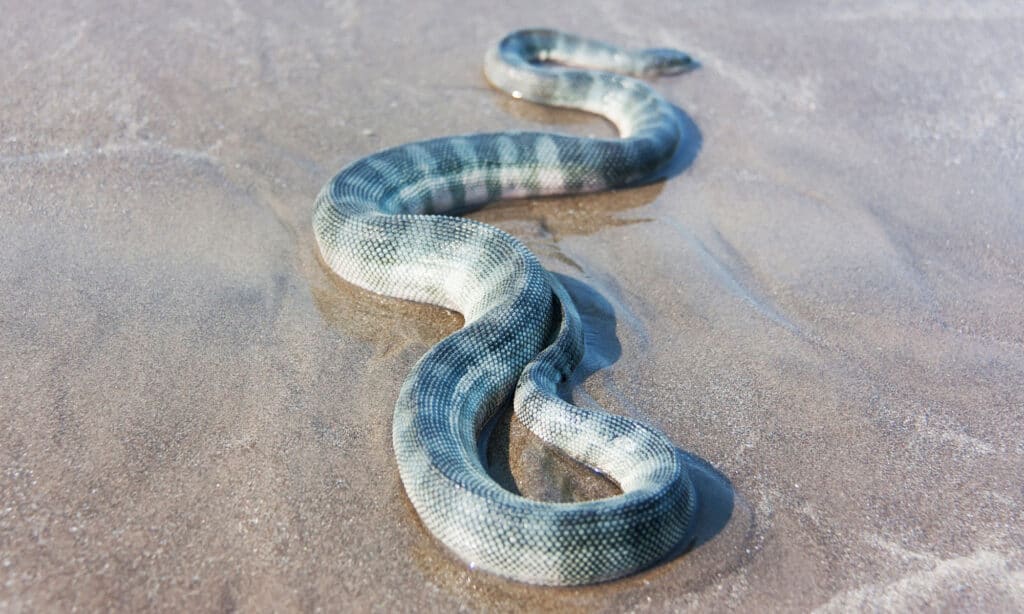It’s time for an epic sea battle! What happens in a fight between the world’s largest stingray vs. most venomous sea snake? In this ultimate animal matchup, we get to find out who wins and why.
In this article, we’ll compare both species’ strengths and weaknesses to see who’s the toughest. The world’s largest stingray was as big as a mini cooper, and the most venomous sea snake could kill eight humans with a single bite.
Which animal has the winning edge in a fight? It’s time to find out. Read on to find out who the winner will be!
Key Points: World’s Largest Stingray vs. Venomous Sea Snake
- The biggest stingray ever found weighed 661 pounds
- The beaked sea snake is the most venomous of all sea snakes
- There are two species of beaked sea snakes, the Australian and Asian, that look identical but are completely different species.
- Stingrays have a venomous stinger or barb in their tail
- Stingrays are bottom feeders and eat mollusks and crustaceans
- Pelagic stingrays mainly eat fish and cephalopods like squid and octopus
- Stingrays have flattened bodies and pectoral fins
- Sea snakes have a flattened tail for efficient swimming
- Sea snakes have salt glands and nostrils on the top of their body
- Sea snakes are hunters; they especially love eels
- There are about 70 known species of sea snakes
- Sea snakes are the most numerous venomous reptiles on Earth and can be found swimming in the Indian Ocean and Western Pacific Ocean.
- Beaked sea snakes have a unique respiratory system that allows them to extract oxygen from the water and stay submerged for extended periods of time.
- Sea snakes have long lungs that allow them to breathe air.
Giant Stingray vs. Venomous Sea Snake: Key Differences
Both of our competitors dine on seafood, but they go about it in different ways. And in a world’s largest stingray vs. sea snake battle, hunting tactics matter a lot.
For starters, stingrays are bottom feeders. They munch on mollusks and crustaceans. In comparison, sea snakes are predators who use precision tactics to hunt down their meals. These snakes feast on fish and eels.
Both species also move differently. Stingery glides gracefully through the water. Their flat bodies move with balance. On the other hand, sea snakes have a serpentine swimming style, allowing them to slither through the waters.
Which competitor is more dangerous? It’s hard to say because they’re both venomous. Stingrays have a deadly stinger on their tails. The stinger helps them defend themselves when not using it for hunting. If they feel threatened, they use the power from their tail to inject the sharp toxic stinger. Sometimes people accidentally trigger this response when they step on stingrays buried in the sand.
All stingrays have a stinger, but not all rays have stingers. You can find these sea creatures in saltwater, freshwater, and brackish area. They live throughout oceans and rivers.
Sea snakes are venomous and thrive in saltwater environments. They have a deadly bite. They use their bite to defend themselves and catch meals. Their venom can cause symptoms such as nausea, dizziness, and fever.
Fatal attacks from sea snakes are rare. These snakes aren’t usually aggressive toward humans. They only bite as a last resort when they feel threatened. Rather than hunting people, sea snakes prefer to dine on eels.

Stingrays have a venomous stinger or barb in their tail.
©BlackFarm/Shutterstock.com
Worlds Largest Stingray
How big was the world’s largest stingray? The biggest stingray in the world measured 13 feet long and weighed 661 pounds. That’s the size of a Mini Cooper! The enormous fish was discovered in the Mekong River in Cambodia. The river passes through several countries, including China, Myanmar, Leos, Thailand, Cambodia, and Vietnam.
Researchers say discovering the giant stingray in the Maikong River is not an isolated incident. This was the fourth giant stingray reported in the same area; all of them have been females. This spot might be a popular area for the species to spawn. Imagine what it’d be like swimming in a river and coming across a stingray that huge!
More Giants of Stringray Kingdom
For this marine matchup, the sea snake will be fighting the 661-pound stingray from the Mekong River. If the snake wants to pick a fight with another large stingray, it’ll have plenty to choose from. Stingrays are a diverse group of rays known for their flat bodies and distinctive stingers. They come in various shapes and sizes.
Here are a few of the world’s largest stingray species in the world, ranked by their body length:
- River stingray
- Eagle stingray
- Whipped tail stingray
- Deepwater stingray
- Butterfly stingray
- American round stingray
The river stingray can grow to an incredible 20 feet in length. This massive ray is native to South America and is one of the largest freshwater fish in the world.
The eagle ray is another giant species that can grow up to 13 feet in length. With its distinctive eagle-like shape and large size, the eagle ray is an impressive creature. Further down the list, we have the whiptail stingray. These can grow up to 10 feet in length. Finally, the deepwater stingray can reach a maximum length of 8.9 feet, which is much bigger than a human.

The river stingray can grow to an incredible 20 feet in length.
©Pavaphon Supanantananont/Shutterstock.com
World’s Most Venomous Sea Snake: Beaked Sea Snake
The beaked sea snake is the most venomous in the world. It’s four to eight times more deadly than a King cobra. Each beaked sea snake’s bite delivers 7.9 to 9 milligrams of venom. That’s a lot of venom when you understand how potent their poison is. It only takes 1.5 milligrams to kill humans. One drop of the beaked sea snake’s venom could kill eight humans. This species accounts for about 90% of fatal bites.
Sea snakes are the most numerous venomous reptiles on Earth. And they’re all over the place. Sea snakes can swim in the waters surrounding the Indian Ocean or the Western Pacific Ocean. But don’t worry. These snakes aren’t out to get you.
Sea snakes prefer to avoid any interaction with humans. Of course, bites do happen. If someone happens to get bitten, they should seek medical attention immediately. The venom of the beaked sea snake can cause paralysis, heart failure, and death. And it only takes a couple of hours for the venom to take full effect.
How Sea Snakes Breathe
How do sea snakes breathe when they’re not underwater? With a lung, of course. The lungs allow them to pull oxygen from the air around them. The gills allow them to extract oxygen that has been dissolved in the water.
Beaked sea snakes have a unique respiratory system. They can extract oxygen from the water around them and stay submerged for extended periods of time. When it’s time to hunt, this nocturnal predator goes after small fish and eels. They use their beaked snout to probe crevices and rocks. They’re always hunting for their next meal.
As a general rule, snakes only have one functioning lung. In the case of sea snakes, the lung is extra long. This helps them bring enough air into their bodies. When they’re not breathing, they close the entrance to the lung, which is called the glottis. Closing the glottis helps them conserve oxygen.

The beaked sea snake is the most venomous in the world.
©iStock.com/Ekaterina Borisova
More Venomous Sea Snakes
For this fight, the beaked sea snake is battling the world’s largest stingray. But what if a different venomous snake wanted to try the ray fish? What other contenders could enter the arena? Let’s take a closer look at the top most venomous sea snakes in the world.
Number one is the olive-headed sea snake. After the beaked sea snake, this one takes the crown as the most deadly of them all. This deadly reptile is found in the Indo-Pacific region with a distinctive olive-colored head. If you encounter one of these snakes, stay far away as possible. Their venom can cause severe muscle weakness and paralysis.
Number two is the black-banded sea krait. This snake is also found in the Indo-Pacific Ocean, and it’s known for its black-and-white banded appearance. If the world’s largest stingray is fighting off against one of these, it’ll have a tough time gaining the advantage. The black-banded sea krait has a powerful venom that also causes paralysis and muscle weakness. However, these snakes aren’t usually aggressive. They only bite if provoked.
Number three, we have the yellow-lipped sea krait. Known for its yellow markings around its mouth, this sea snake’s venom is fierce. Their bite is milder compared to the olive-headed sea snake, but it can still cause muscle weakness.

The black-banded sea krait has a powerful venom that also causes paralysis and muscle weakness.
©Rich Carey/Shutterstock.com
Can Stingrays Eat Poisonous Snakes?
Would a stingray try to eat a venomous sea snake? It’s not likely. These fish prefer to dine on crustaceans and small invertebrae like prawns. This was seen in a study done on the pelagic stingray. They analyzed 84 stomachs of these fish caught in the Northern Adriatic Sea between April 2004 and October 2005. You won’t believe what they found out about their diet.
It turns out the pelagic stingray mainly eats fish and cephalopods like squid and octopus. There were a few crustaceans thrown in there too. Some of their favorite fish included anchovy, cuttlefish, and red bandfish.
And get this, as the size of the prey increases, so does the predator. So as the pelagic stingray grows, it eats bigger and bigger fish. Overall the study sheds light on the fact that the pelagic stingray is a top predator of pelagic fish species. However, it doesn’t just stick to the open water. They also feed on prey from the bottom of the sea.
Would the sea snake want to eat the stingray? Not under normal circumstances. Sea snakes eat eels, certain fish, and young octopi. They don’t normally dine on stingrays, and they especially don’t dine on them when they’re the size of a car!
Deadly Sea Snakes with Venomous Doppelgangers
Our venomous sea snake competitor has a twin! Or a doppelganger. There are Asian and Australian beaked sea snakes. They’re completely different species, but up until recently, everyone thought they were the same snake! Oops.
Scientists made an interesting discovery about the lethal beaked snake. They found out that what was previously thought to be one of these species is actually two separate species. There’s the Australian beaked sea snake and the Asian beaked sea snake. And they’re two completely different species, and they aren’t even related. The snakes just happen to look identical. Using DNA comparison, researchers were finally able to tell these two look-a-like snakes apart.
The craziest part is that for years, researchers unknowingly made antivenom for both species using the other snake’s venom. And the antivenom worked too! Researchers had no idea they were using a different species of venom to make the lethal beaked snake antivenom. The antivenom was still effective because all sea snakes have similar venom.
Having two identical sea snakes is a great example of convergent phenotypic evolution. This is where two species evolve separately but end up looking similar. The beaked appearance of these snakes is associated with their habitat. They live in shallow silt-filled areas of tropical estuaries in Asia and Australia.
Stingray vs. Sea Snake: Fatal Attacks
As we’re winding up this animal battle, let’s see which competitor has the easiest reputation for fatal attacks. Neither species is known for targeting people. But when a species is scared or threatened, they sometimes react with lethal force.
Stingray Fatal Incident
Stingrays sometimes hurt people by accident, and it’s rare. This can happen when someone steps on a stingray hiding in the sand or when one jumps out of the water. In one instance, a woman visiting the Florida Keys suffered fatal injuries after being struck in the face and neck by a spotted eagle stingray. The stingray jumped out of the water and hit her while she was on a boat.
Spotted eagle rays aren’t aggressive. They will, however, jump out of the water. These stingrays can grow up to 17 feet in length and weigh up to 500 pounds.
Sea Snake Fatal Incident
Sea snakes are highly venomous, but their limited contact with humans means bites are relatively rare. Australia has 30 of the 70 known species of sea snakes. There have been no recorded deaths from sea snake bites in Australia until recently.
A 23-year-old UK fisherman named Harry Evans died after being bitten by a sea snake. He was pulling a net on a trawler in the Gulf of Carpenteria, off the coast of Northern Territory, Australia.
Experts say sea snake bites could be prevented as fishing companies educate workers on how to handle sea snakes and protect themselves. This was the first death of a trawler fisherman due to a sea snake bite in Australia, but it’s not the first death ever.
Who Wins?
The venomous sea snake is the winner. And here’s why! Both of our competitors have a lot of advantages in this animal matchup. The world’s largest sting ray has an impressive size and venomous stinger. But being big isn’t always an advantage in a fight.
The stingray lacks the agility of the slithering sea snake. In a fight, the sea snake would have the advantage of being able to attack from multiple angles. They’d be able to maneuver their body and land strikes on the stingray quickly. The snake could attack from here, there, and everywhere. The stingray wouldn’t even know where to defend themselves. And if they tried to retaliate, things wouldn’t go well.
Being a flat, round disc, the stingray would have a more difficult time landing a single hit on the sea snake. Just picture a flying saucer trying to hit a slender eel, and you’ll get the idea. The pancake body of the stingray is great for gliding to escape hungry sharks but is not well equipped for battling snakes.
In the real world, these species would never fight. But for this hypothetical animal matchup, the answer is clear. The sea snake is the winner! Using its long body, stealth, and deadly venom, this aquatic reptile has the advantage.
The photo featured at the top of this post is © R raymoonds/Shutterstock.com
Thank you for reading! Have some feedback for us? Contact the AZ Animals editorial team.






